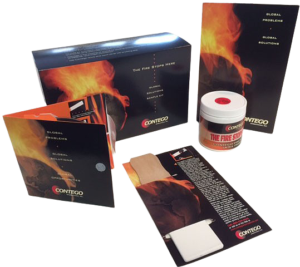9/11 and Why Adhesion Matters with Fire Retardant Paint

The delamination on this example shows that poor application can cause failure of adhesion just as an explosion can.
Utilizing fire retardant paint for your fireproofing needs is more than just adhering to building guidelines — it can mean life or death. The tragedy of 9/11 made the case for that point forever.
“If the steel in the World Trade Center could have been adequately protected for just a little longer, it might not have fallen,” says Tony Scott, Contego executive vice president.
As flames engulfed the Twin Towers, the steel was exposed to temperatures of more than 2,000 degrees Fahrenheit, hotter than a normal cellulosic fire because of the jet fuel.
However, an even bigger problem was the total failure in adhesion. The impact completely stripped the substrates of their protective coating.
When heated to 1,000°F, steel loses half its strength: For instance, a beam supporting 2,000 tons could only support half that weight at 1,000°F, putting the entire structure at risk. “The World Trade Center collapsed because it could no longer support itself,” says Scott, “The weight of the floors above the failure acted like a pile driver collapsing the floor below. The increasing momentum guaranteed the total destruction of the Towers.”

By making sure you’ve used an intumescent product with excellent adhesion, you’ll keep structural steel (or any underlying substrate) cool and intact during a fire.
Fire retardant paint keeps steel from reaching dangerous temperatures by insulating the substrate, even in extreme conditions. As flames heat the steel, the substrate loses shape. But fire retardant paint with strong adhesion allows the coating to continue to stick to the steel without flaking off.
While the fire might be burning at 2,000 degrees Fahrenheit, the coating keeps the steel at a safe temperature for as long as possible.
Fire-resistant coatings can’t withstand heat indefinitely, but the aim is to protect the steel long enough so the fire burns out or help arrives.
Furnace fire tests and control burns show that Contego protects steel “extremely well for up to three hours restrained,” says Scott.
For more on the best way to test the adhesion of fire retardant paint and how to pick the perfect fire-resistant coat for your project, download our eBook.

